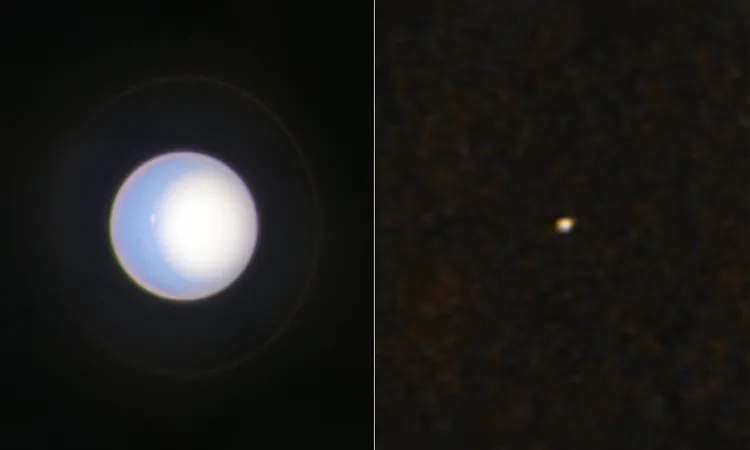
Hubble and New Horizons Join Forces to Unlock Secrets of Uranus and Exoplanets!
2024-10-24
Author: Wei
Cosmic Insights from Uranus
This stellar cooperation involved using high-resolution images captured by Hubble and comparing them with the distant observations from New Horizons, which was stationed about 6.5 billion miles away. As a result, researchers were able to analyze Uranus’s twilight crescent—a phenomenon impossible to observe from Earth.
Lead scientist Samantha Hasler from MIT expressed her excitement about the findings, noting, "While we expected Uranus to appear differently in each filter of the observations, we found that Uranus was actually dimmer than predicted in the New Horizons data taken from a different viewpoint."
Illuminating Exoplanet Studies
Understanding exoplanets is crucial for astronomers, and one of the key methods is direct imaging. This technique involves collecting light reflected by these distant worlds and examining variations in their brightness across different wavelengths. Unfortunately, the extreme distances make this task incredibly challenging.
The use of Uranus as a proxy allows scientists to refine their imaging techniques, providing invaluable clues about how gas giants reflect light. By complementing Hubble's detailed atmospheric features with New Horizons’ wider perspective, astronomers gain deeper insight into how exoplanets may appear when observed by future telescopes.
A New Perspective on Atmospheric Dynamics
The atmospheres of gas giants like Uranus are notorious for their dynamic and unpredictable nature. By comparing Hubble’s detailed views with New Horizons’ data, researchers are gaining improved understanding of atmospheric changes not only in Uranus but also in far-off exoplanets.
Hasler elaborated, “With Hubble providing context, we can see how Uranus behaves when viewed from a distance, much like how exoplanets will be seen in observations from telescopes like the James Webb.
What Lies Ahead for Uranus Research?
NASA is preparing for several ambitious observatories in the coming years, all aimed at deeper exploration of exoplanet atmospheres and their habitability potential. Experts are optimistic about these upcoming missions, which promise to unravel the mysteries surrounding distant worlds.
"Studying how known benchmarks like Uranus appear in distant imaging will help us set more robust expectations for these future missions," Hasler concluded. "That knowledge will be critical for our success."
New Horizons: A Legacy of Exploration
Launched in January 2006, New Horizons revolutionized our understanding of the outer solar system. The spacecraft famously performed a historic flyby of Pluto in 2015, sending back detailed images and valuable data about the dwarf planet and its moons. In 2019, it ventured further to explore Arrokoth in the Kuiper Belt, offering a glimpse into the solar system's formative years.
A Leap Forward in Exoplanet Research
The collaborative efforts of Hubble and New Horizons mark a significant step towards understanding exoplanets better. This exploration not only provided valuable insights into Uranus but also prepared scientists for what they should anticipate in their future quests within the realm of exoplanetary science.
Research findings from this revolutionary study will be presented at the upcoming 56th annual meeting of the American Astronomical Society Division for Planetary Sciences, promising groundbreaking discussions about the future of space exploration.
Stay tuned, as the secrets of the universe continue to unfold!



 Brasil (PT)
Brasil (PT)
 Canada (EN)
Canada (EN)
 Chile (ES)
Chile (ES)
 Česko (CS)
Česko (CS)
 대한민국 (KO)
대한민국 (KO)
 España (ES)
España (ES)
 France (FR)
France (FR)
 Hong Kong (EN)
Hong Kong (EN)
 Italia (IT)
Italia (IT)
 日本 (JA)
日本 (JA)
 Magyarország (HU)
Magyarország (HU)
 Norge (NO)
Norge (NO)
 Polska (PL)
Polska (PL)
 Schweiz (DE)
Schweiz (DE)
 Singapore (EN)
Singapore (EN)
 Sverige (SV)
Sverige (SV)
 Suomi (FI)
Suomi (FI)
 Türkiye (TR)
Türkiye (TR)
 الإمارات العربية المتحدة (AR)
الإمارات العربية المتحدة (AR)